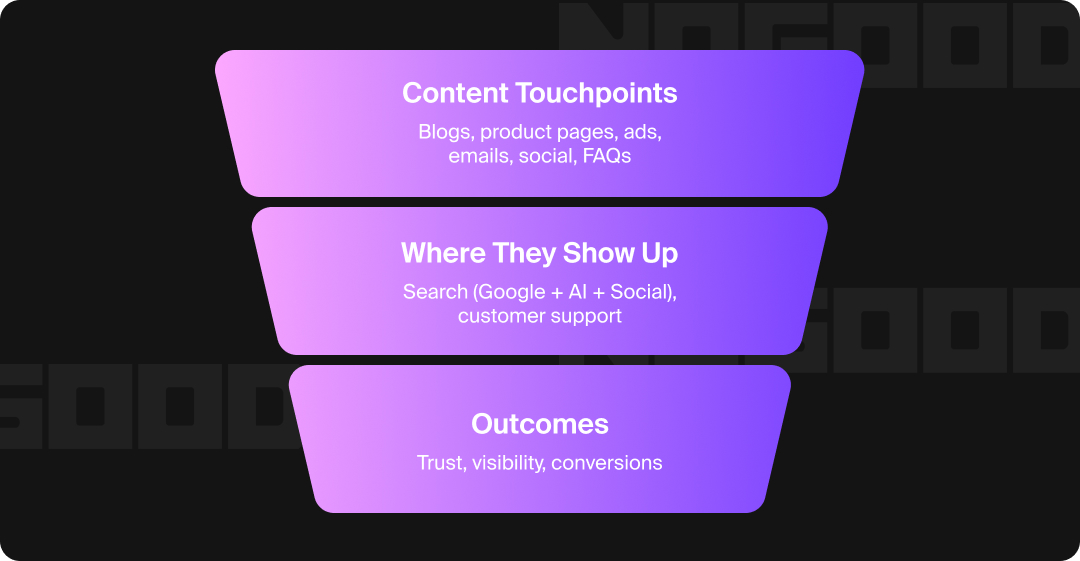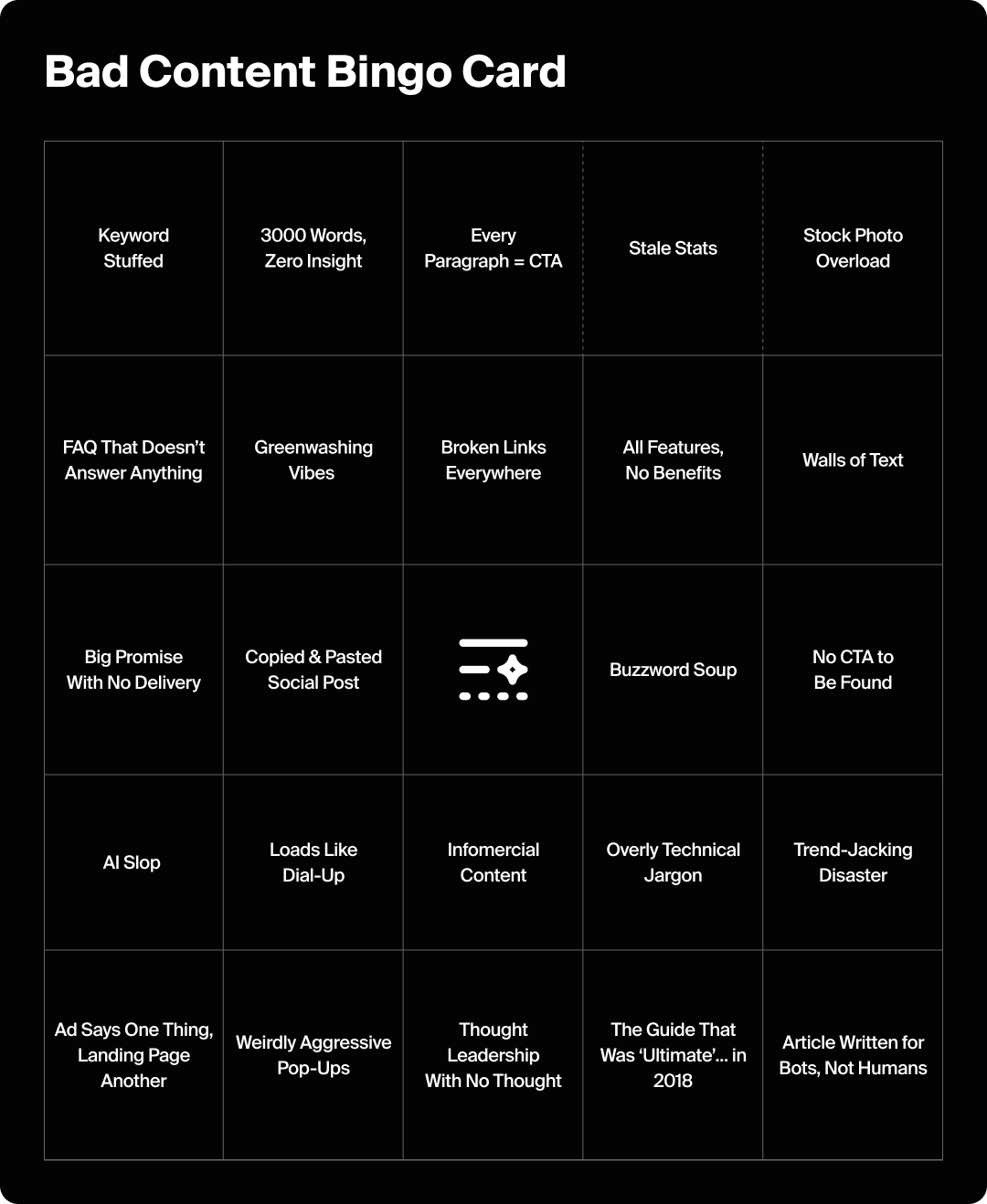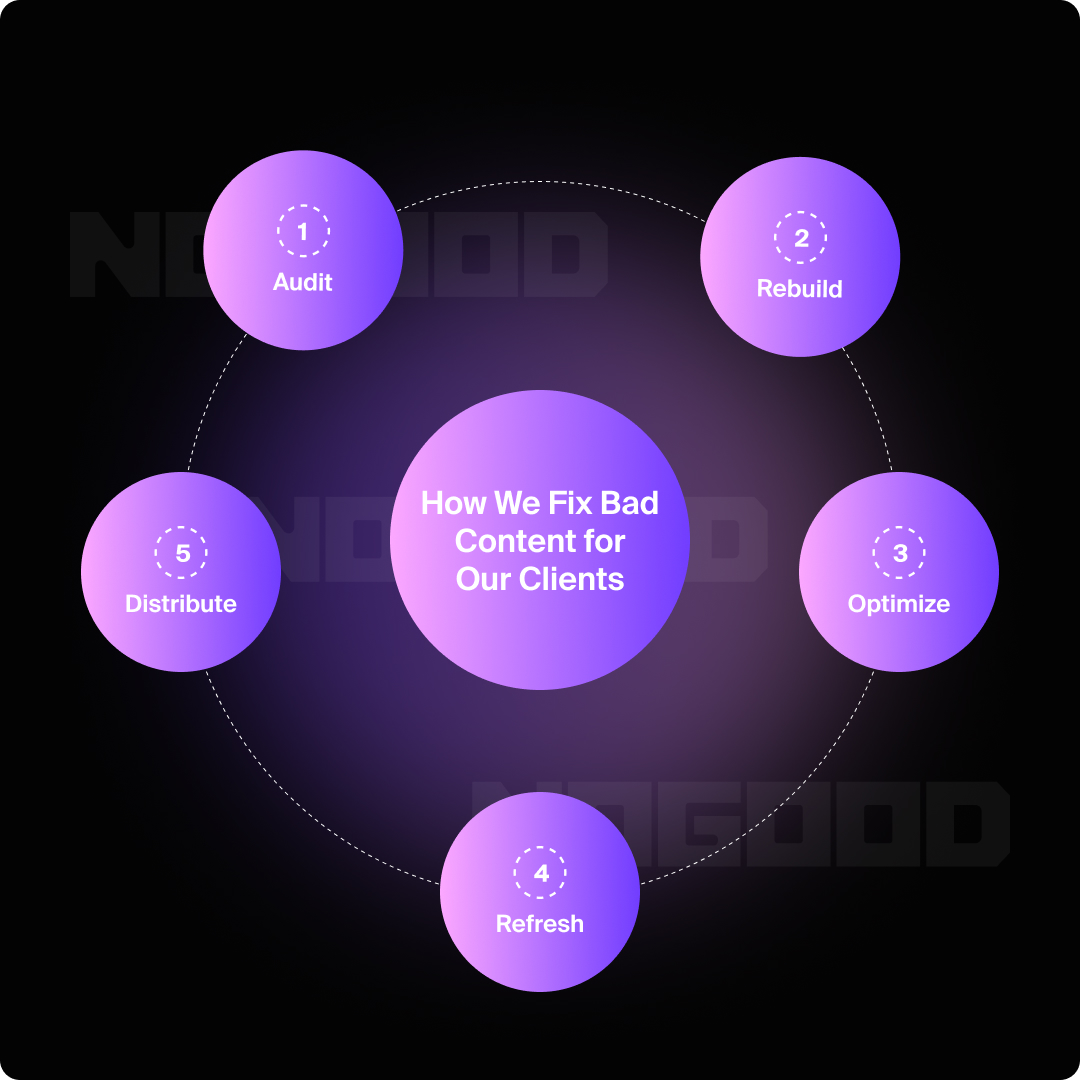I love and obsess over content. Written, visual, audio, social media, and even the less glamorous stuff like forums, FAQs sections, and support docs. I’m the kind of person who never skips commercials because I’m fascinated by how brands use those precious seconds (or longer, if they’re lucky) to capture attention.
Deviously, my guilty pleasure is bad content marketing examples. Even if you’re putting out content organically, a lot of money, time, and effort go into producing said content. So when it goes wrong, I want to analyze what happened and theorize why. Call it professional curiosity; I work in growth marketing, which basically means I get paid to obsess, find the cracks, and figure out how to fix them. It’s actually my favorite part.
Consider this your survival guide to understanding what makes content bad, how to avoid these mistakes, what bad content can cost you, and how to fix it if you haven’t yet. And as a bonus, I’ll give you a look into *my* personal process 🙂
Why Content Matters in the First Place

For a long time, I think brands have (mistakenly) treated content like an afterthought; a blog to check the SEO box and a social post because “we should probably be on Instagram.” But if the old phrase “content is king” ever felt like an exaggeration, it certainly isn’t anymore.
Content touches everything: your product descriptions, ad campaigns, landing pages, blogs, emails, social posts, and even your customer support docs. It’s the connective tissue across every channel where people discover, evaluate, and decide on which brand they’re going to give their hard-earned money to.
And the stakes have never been higher, people! Search is multimodal (text, video, images, voice), AI assistants and traditional search engines pull from content to shape answers and results, and social media trends dictate cultural relevance in real time.
And the data is backing this up: 78% of shoppers research social media before making a purchase, 81% research online before buying or visiting a store, and a study by Goodie shows that AI Search engines like ChatGPT and Gemini pull directly from your owned, branded content to generate answers.
All of this goes to say that content is super important these days. Not just to readers and potential customers, but also to succeed on the very platforms (like AI and Google) that shape how customers find and judge you. If your content isn’t strong, your brand won’t stand a chance at making it into the conversation (unless you’re a behemoth like Apple or Nike).
What Makes Bad Content
Bad content isn’t always obvious. I would argue that it can take a trained eye (like the NoGood team’s 👀) to point out the flaws that might be blocking your conversion funnel. Sometimes a piece of copy looks fine on the surface: the right length, the right keywords, maybe even a couple of pretty graphics… but it’s still missing the mark. So what makes content bad?

Bad content usually falls into one (or more) of these traps:
- It’s irrelevant and doesn’t speak to the audience’s needs or intent.
- It’s thin or shallow, lacking depth, originality, or useful takeaways.
- It’s overly salesy and reads like an ad instead of solving a problem.
- It feels untrustworthy and makes claims without data, sources, or credibility.
- It’s poorly structured with large walls of text, no visuals, and confusing flow.
- It’s outdated and includes old stats, advice, or trends that are no longer relevant.
- It’s spammy or full of AI-fluff, such as keyword stuffing, filler, or overly prioritizing algorithms instead of people.
The best-case scenario is that bad content fails to help your brand. But more often, bad content actively hurts your brand. From lower search rankings to AI engines skipping over you and audiences bouncing at first glance, weak content signals that your brand isn’t trustworthy, let alone worth their precious pennies.
The Real Cost of Bad Content for Brands
Now that we know about what can make bad content, well, bad, let’s discuss how this costs brands. Bad content doesn’t just sit quietly in the corner of your website and social media profiles. It costs money, time, trust, and opportunity. Here’s how:
- Wasted resources. Every piece of content takes time, budget, and energy. When it flops, those hours and dollars are gone for good.
- Lost visibility. Search engines and AI assistants skip over weak, irrelevant, or unhelpful content. That means your competitors get the clicks, the citations, and the spotlight.
- Damaged credibility. Customers can smell low-effort content from a mile away. Thin articles, lazy product descriptions, or tone-deaf social posts send the message that your brand just isn’t trustworthy.
- Missed momentum. Content that doesn’t get shared, linked, or cited doesn’t compound over time. You lose out on the long-tail ROI that strong content delivers.
- Lower conversions (and did I mention money?). Bad content confuses or bores readers instead of guiding them toward action. Result? Higher bounce rates, fewer sign-ups, and less revenue.
Once you lose trust or visibility, it’s expensive and slow to win it back (but not impossible). So what does bad content look like, and how can it be fixed?
11 Bad Content Marketing Examples (& Fixes)

Bad content comes in many flavors: some are bland, and others are downright painful for me to look at. Let’s walk through some examples that you’ve likely seen (or maybe even published… no judgement though 😬).
1. The Blog That Says Nothing
The Problem: We’ve all clicked on something titled “10 Proven Ways to Skyrocket Your Sales” only to find 800 words of regurgitated fluff: “Focus on your customer,” “be authentic,” “work hard.” What are we supposed to learn from that nothing burger?
Why It’s Bad: You’re wasting your reader’s time and signaling to search engines and AI tools that you don’t have anything original to say. This results in higher bounce rates, fewer backlinks, and zero AI citations; all levers that drive organic growth. Without them, your content is invisible in search and irrelevant in the spaces where buyers make decisions.
Why Brands Should Care: Blogs are often a customer’s first introduction to your brand. If they leave unimpressed, you’ve lost both visibility and credibility. Worse, you’ve wasted budget producing something that actively damages brand perception.
The Fix: Content creation means figuring out how to sound like an expert in the subject at hand (even if you aren’t one, take it as an opportunity to learn). Do your research thoroughly, double-check every claim, and lead with real, tangible insights like data, case studies, and POVs instead of just filler that ChatGPT can write for you.
2. Product Pages That Are All Specs
The Problem: You land on a product page that’s basically just a spreadsheet pasted into a CMS. Weight, dimensions, technical jargon, but no explanation on why any of it matters. It’s easy for brands to think “we listed the features, job done,” but customers don’t buy specs, they buy solutions!
Why It’s Bad: Specs without context leave the reader to do the mental gymnastics. They have to figure out how a “40mm driver” translates into a better listening experience, or why “2.1 lbs” is a selling point. That gap kills momentum, creates friction, and pushes them to competitors who make their benefits clear and obvious.
Why Brands Should Care: Product pages are the money pages. A lackluster description means lost conversions, wasted ad spend, and high bounce rates. Even your best SEO and paid campaigns can’t save a weak page.
The Fix: Translate features into outcomes your customer can feel. Instead of “40mm driver,” say “cinematic bass that pulls you into the game.” Instead of “lightweight design,” say “comfort that lasts through marathon sessions.” That shift makes your product relatable, persuasive, and conversion-ready.
3. The Trend-Jacking Campaign That Backfires
The Problem: A brand jumps on a trending hashtag, cultural moment, or a social issue without doing the homework. The post feels opportunistic, off-brand, inauthentic, and out of touch.
Why It’s Bad: The court of public opinion is ruthless. Inauthentic content gets ratioed, screenshotted, and memed into oblivion, and that isn’t the kind of visibility that you want. What was intended to be clever becomes a PR liability.
Why Brands Should Care: Reputation is a multiplier. When trust dips, every marketing dollar works harder for less return. Customers and audiences will be less likely to engage, click, or buy from a brand they don’t believe in.
The Fix: For the love of all that is holy, stay in your lane. Only participate in cultural conversations where your brand can add authentic value. Run campaigns through a values check: does this align with who we are, or are we forcing it? This isn’t one of those you can run back as easily.
4. The Evergreen Content That’s Wilted
The Problem: It’s not just old blog posts that gather dust. Landing pages, FAQs, product descriptions, and even ad copy can all become outdated. Maybe the stats are old, the screenshots don’t match the current UI, or the offer no longer exists; but the associated content is still out there representing your brand.
Why It’s Bad: Outdated content signals neglect everywhere it shows up. Customers who see old information lose trust. Search engines and AI models downgrade your content because it’s no longer accurate. Even sales teams can suffer if they’re sending prospects resources that feel irrelevant.
Why Brands Should Care: Evergreen assets are meant to work like compounding interest: gaining value the longer they’re live. When they go stale, you lose that ROI and risk confusing customers and handing market share to competitors with fresher, updated, and more relevant answers.
The Fix: Build in refresh cycles across all content types, not just blogs. That means revisiting your landing pages, updating FAQs, swapping out ad creatives, and re-optimizing product pages regularly. Small updates keep assets trustworthy and ensure that they keep working for you long-term.
5. The Oversell (AKA The Infomercial Approach)
The Problem: Overselling can sneak into every corner of your content strategy. Blogs that read like product brochures. Landing pages stuffed to the brim with “Buy Now!” buttons. Social posts that shout offers without context. Emails that feel more like spam than valuable messaging.
Why It’s Bad: Customers tune out when they sense desperation. In fact, studies show 85% of ads never even hit the attention threshold needed to make an impact. Oversell content gets ignored, unsubscribed from, and skipped over. Worse still, it positions your brand as pushy rather than helpful, killing trust before a real relationship can even form.
The Fix: Lead with value across every channel. Teach, entertain, or inspire first. A well-placed CTA will feel natural once trust is earned. Whether it’s a blog, an email, or a TikTok, the principle is the same: educate first, sell second.
6. The Copy-Paste Social Post
The Problem: A brand takes one message (such as a product launch) and blasts the exact same caption across LinkedIn, Instagram, and TikTok. No tone shift, no platform-native formatting, just plain old copy-paste.
Why It’s Bad: Each platform has its own “language.” LinkedIn thrives on thought leadership, Instagram rewards visuals and storytelling, TikTok favors short, casual bursts of authenticity. A one-size-fits-all approach makes you look robotic and out of touch (even if your Gen X boss thinks it looks “more cohesive”).
Why Brands Should Care: Social is often the top of your funnel; it’s the first place where a customer interacts with your brand. If you come across as irrelevant or tone-deaf, you’re burning visibility and ad spend while pushing prospects toward competitors who do speak their audience’s language.
The Fix: Keep your message consistent, but tailor the execution. That might mean a polished LinkedIn post, a behind-the-scenes TikTok, and a carousel on Instagram; all pointing to the same launch, but speaking the native language of each platform.
7. The FAQ Section That Doesn’t Actually Answer Questions
The Problem: Your FAQ page looks robust, but gives vague answers: “Q: How fast is shipping? A: Very fast!” or “Q: Can I cancel anytime? A: Of course!” To the reader, these start to sound more like evasions instead of answers. Another common mistake is trying to use the FAQ page as a support page, stuffing it with troubleshooting and technical content instead of using it to actually answer pre-purchase questions and remove friction from the buying journey.
Why It’s Bad: Customers arrive at your FAQs because they’re on the verge of converting, but need clarity and additional details to make the final purchase decision. When answers are vague, misleading, or poorly targeted, frustration builds and trust erodes.
Why Brands Should Care: Supporting content is part of marketing. A clear FAQ reduces customer service costs, improves conversions, and reassures buyers at the critical decision-making stage. A bad FAQ does the opposite: more tickets for your support team, fewer completed purchases, and churn among new users or customers.
The Fix: Anticipate real objections and answer them directly. Instead of “fast shipping,” say “2–3 business days, free on orders over $50.” Instead of “cancel anytime,” say “Cancel in two clicks, no hidden fees.” Clarity builds trust, which in turn builds conversions.
8. The Ad That Promises Too Much
The Problem: A clickbait-y ad screams “Get results in 7 days!” or “50% off EVERYTHING,” and the landing page reveals watered-down offers, exclusions, or a completely different product.
Why It’s Bad: Customers feel tricked. Even if you get that initial click-through, the disconnect kills conversions and damages trust. Performance will suffer too; ad platforms punish low-quality experiences by slapping you with higher bidding costs.
Why Brands Should Care: Paid campaigns are expensive enough without wasted clicks. Misaligned ads increase CAC (customer acquisition cost), eat into budgets, and sabotage ROI. Worse, they condition customers to ignore your brand’s ads in the future.
The Fix: Match your ad promises with real landing page experiences. If you say “50% off of everything,” it had better be across the board. Honest, expectation-aligned ads may earn fewer initial clicks, but they convert better, cost less, and build brand equity over time.
9. The Email That Never Ends
The Problem: A brand tries to cram a whole blog post into an email. Paragraphs of text, multiple competing CTAs, and no clear hierarchy. By the third scroll, the reader has already hit “archive”; or worse, “unsubscribe.”
Why It’s Bad: People don’t read emails like they read blogs. Inboxes are already cluttered and attention spans are shortened, so clarity is everything. Overstuffed emails feel overwhelming and get ignored.
Why Brands Should Care: Email is one of the highest ROI channels: $36 return for every $1 spent (when done well). But if your open and click-through rates plummet because your emails are unreadable, you’re squandering one of the cheapest and most direct ways to nurture leads.
The Fix: Keep emails short, scannable, and focused on one core message or CTA. Link out to longer content if needed. Think appetizer, not full-course meal.
10. The Campaign With No Next Step
The Problem: A brand puts effort into creating a great piece of content (a blog, a video, a landing page) but forgets the CTA. The reader finishes the content and… nothing. No link to a product page, no form, not even a “learn more.”
Why It’s Bad: Attention is hard to earn. When you get it and don’t direct it, you’re wasting a critical opportunity.
Why Brands Should Care: Every piece of content should be part of a conversion path. Without a next step, you’re not nurturing leads or moving customers closer to purchase. Instead, you’re training them to consume your content and then drift away to competitors.
The Fix: Always provide a logical next step. That doesn’t mean pushing for a sale in every piece; sometimes it’s simply “read more,” “subscribe,” or “watch the demo.” But there should always be a bridge to keep the journey going.
11. The Jargon Overload
The Problem: Some content tries so hard to sound smart that it forgets to be clear. Phrases like “synergize omnichannel ecosystems” or “future-proof paradigm shifts” may impress your stakeholders, but they leave real readers scratching their heads.
Why It’s Bad: Jargon creates distance instead of connection. It confuses prospects, alienates your audience, and makes your brand feel inaccessible. Even worse, AI engines and search algorithms aren’t fooled by your big-brain words; they prioritize clarity and relevance over buzzword soup.
Why Brands Should Care: Marketing campaigns are too expensive to waste it on content your customers don’t understand. Clear, plain language widens and builds trust with your audience. If people and search engines (including LLMs) can’t quickly understand what you do and why it matters, they’ll skip you for a competitor who can explain it simply.
The Fix: Replace jargon with regular, everyday human language. Keep it simple. Instead of “AI-powered synergy platform,” say “Smarter software that saves your team hours every week.”
How We Fix Bad Content for Clients

Spotting bad content is only half the battle; fixing it is where the real work (and growth) happens. At NoGood, our content marketing process isn’t about quick hacks or patch jobs. We take a structured, repeatable approach that transforms underperforming content into long-term growth assets (it’s how we get a lot of our clients, too!).
While I can’t show you all of my cards (you’ll have to become a client for that 😉), here’s a peek into our process:
1. Audit & Diagnose: We start with a deep dive into your content ecosystem: blogs, product pages, landing pages, ads, FAQs, even support docs. The goal is to surface what’s working, what’s underperforming, and where content is actively hurting your brand.
2. Rebuild for Relevance: Thin, vague, or outdated content gets reworked with substance, structure, and originality. We inject subject-matter expertise, fresh data, and perspective so your content stands out instead of blending in.
3. Optimize for Humans & Algorithms: Good content needs to hit both audiences. We shape content to be scannable, valuable, and engaging for readers; while also aligning with how search engines and AI tools evaluate authority, trust, and quality.
4. Refresh & Repurpose: Evergreen doesn’t mean untouched. We build refresh cycles into your strategy and repurpose strong assets across channels (social snippets, email, short-form video) so your best content works harder for you.
5. Distribution & AI Visibility: Publishing isn’t the finish line. We distribute and track content strategically across organic search, social, and paid while also monitoring how it performs in AI search (via Goodie) so you’re visible in Google’s AI Overviews, ChatGPT, Gemini, and beyond.
The Result: Instead of content that’s ignored (or mocked), you get a library of assets that compound value over time, building authority, trust, and revenue.
The Glow-Up Your Content Deserves
Bad content is like bad leftovers: nobody wants it, and it won’t get better with time. The good news is that it’s fixable. Whether your brand is dealing with stale blogs, cringe-worthy campaigns, or product pages that read like spreadsheets, we know how to turn it around.
So, if your content is giving “bad example” energy, let’s change that. Work with NoGood and we’ll make sure your content ends up on the “best practices” list instead.






